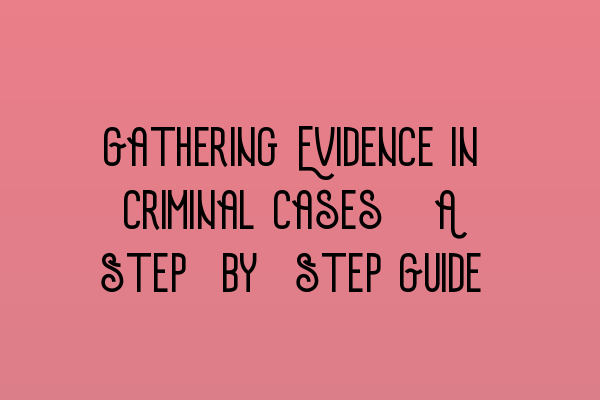Gathering Evidence in Criminal Cases: A Step-by-Step Guide
When it comes to criminal cases, gathering evidence is crucial in order to build a solid defense or establish guilt. The process of gathering evidence requires careful planning, attention to detail, and a comprehensive understanding of the legal procedures involved. In this step-by-step guide, we will explore the essential steps to effectively gather evidence in criminal cases.
Step 1: Case Assessment
The first step in gathering evidence is to thoroughly assess the case. This involves understanding the charges, studying the relevant laws and regulations, and identifying potential defense strategies. By conducting a comprehensive case assessment, you can determine the specific types of evidence that will be most beneficial to your case.
A good starting point for your case assessment is to review the SQE 1 Practice Exam Questions to familiarize yourself with the types of legal scenarios and questions you may encounter. This will help you identify the specific areas in which you need to gather evidence.
Step 2: Identify and Preserve Key Evidence
Once you have assessed the case, the next step is to identify and preserve key evidence. This includes physical evidence, documentary evidence, and testimonial evidence. Physical evidence may include items such as weapons, fingerprints, or DNA samples. Documentary evidence can consist of written records, contracts, or photographs. Testimonial evidence involves witness statements and expert opinions.
During this step, it is crucial to follow proper procedures to ensure the evidence is admissible in court. This may involve obtaining search warrants, taking photographs or videos of the crime scene, or conducting forensic analysis. It’s important to consult with professionals, such as forensic experts, to gather and preserve the evidence properly.
For more information on preserving evidence, you can refer to our article on SQE 2 Preparation Courses, which provides valuable insights into the techniques and practices used in collecting and preserving evidence for criminal cases.
Step 3: Conduct Interviews and Depositions
After identifying and preserving key evidence, the next step is to conduct interviews and depositions. This allows you to gather additional information, obtain statements from witnesses, and uncover any inconsistencies or discrepancies in their accounts. It is essential to prepare thorough questions and conduct interviews in a professional and unbiased manner.
When conducting interviews and depositions, it’s important to consider the guidelines and best practices outlined in our article on SQE 1 Preparation Courses. This resource provides valuable tips on effective interviewing techniques and how to elicit the most relevant information from witnesses and other parties involved in the case.
Step 4: Analyze and Organize Evidence
Once you have gathered all the necessary evidence, it is crucial to analyze and organize it effectively. This involves a thorough review of all documents, photographs, and witness statements to identify patterns, inconsistencies, or any potential weaknesses in the prosecution’s case.
Organizing the evidence in a logical and coherent manner is also important to present a strong argument in court. This can be achieved by creating an evidence binder or digital folder with labeled sections for each piece of evidence.
Step 5: Prepare the Defense Strategy
Based on the evidence analysis, it is time to prepare the defense strategy. This involves developing a cohesive narrative that aligns with the evidence gathered. The defense strategy should address the weaknesses in the prosecution’s case, challenge the reliability of the evidence, and present a strong argument in favor of the accused.
When preparing the defense strategy, it’s crucial to consider the rules of evidence and the requirements of the SRA SQE Exam Dates. Compliance with these regulations is essential to ensure the admissibility of the evidence and the effectiveness of the defense strategy.
Conclusion
Gathering evidence in criminal cases requires meticulous attention to detail, a comprehensive understanding of legal procedures, and the ability to integrate various pieces of evidence into a cohesive defense strategy. By following the step-by-step guide outlined above, you can effectively gather and present evidence in order to achieve the best possible outcome for your client.
For further practice and preparation, we recommend exploring our SQE 1 Practice Mocks FLK1 FLK2, which provide additional opportunities to refine your skills in gathering and analyzing evidence.
